In today’s world, with our changing climates and evolving beauty standards, dry skin is an issue many grapple with. While it’s a common concern, understanding its roots and finding solutions tailored to individual needs is crucial. This article sheds light on the causes, symptoms, and daily habits influencing dry skin, empowering you to maintain that healthy glow.

What is Dry Skin?
Dry skin, medically termed as “xerosis,” is more than just an occasional tight feeling after skipping a moisturizer. It’s characterized by a lack of moisture in its outer layer, sometimes leading to a rough and scaly appearance.
Temporarily vs. Chronically Dry
Everyone experiences dry skin at some point, but for some, it’s a persistent battle. While occasional dryness might be due to weather changes, chronic conditions require deeper understanding and care.

Primary Causes of Dry Skin
To truly address and manage dry skin, it’s pivotal to delve deep into its primary triggers. By pinpointing the exact culprits, we’re better equipped to tackle its challenges head-on and adopt a proactive approach to skin care.
Let’s navigate the primary factors behind dry skin and arm ourselves with the knowledge to keep our skin hydrated and glowing.
- Environmental Factors
- Water Exposure
- Skincare and Cosmetic Products
- Medical and Genetic Factors
A. Environmental Factors:
Cold Weather and Low Humidity: The chill of winter does more than just encourage us to bundle up. With the dip in temperatures, the air becomes less capable of holding moisture, often stripping our skin of its natural hydration. This cold, dry atmosphere saps the moisture directly from our skin, leaving it feeling parched and vulnerable.
Indoor Conditions: Those comforting indoor environments we retreat to, with their heaters or air conditioners, can often be a double-edged sword for our skin. While they regulate temperatures for our comfort, these systems inadvertently lower indoor humidity, which can cause our skin to lose its natural moisture. Over time, exposure to such conditions may lead to skin feeling dehydrated and tight.

B. Water Exposure:
Showering and Bathing: There’s no doubt that a hot, steamy shower can feel like a luxurious escape, but it might be doing more harm than good to your skin. Prolonged exposure to hot water can break down the lipid barriers in your skin, causing it to lose natural oils that keep it hydrated. The result? Skin that feels tight and noticeably drier post-shower.
Swimming: Taking a dip in a cool swimming pool is a summer staple, but that refreshing plunge could be problematic for your skin. Chlorine, used to keep pools clean, can be highly drying, disrupting the skin’s natural balance of oils. If you’re a frequent swimmer, you may find that your skin becomes rougher and more dehydrated over time.

C. Skincare and Cosmetic Products:
Harsh Products: Cleansing should be a gentle process, but we often fall into the trap of using aggressive, stringent cleansers in hopes of achieving ‘squeaky clean’ skin. These products can strip your skin of essential natural oils, leading to an imbalance that ultimately causes dryness. Instead of feeling rejuvenated, your skin may feel tight and uncomfortable after cleansing.
Cosmetic Mismatch: When it comes to cosmetics, one size definitely does not fit all. Products designed to control shine in oily skin types may lack the moisture needed for dry skin, leaving it feeling parched. It’s essential to choose cosmetics that align with your specific skin needs, especially when battling dryness, to ensure you’re not inadvertently exacerbating the problem.
D. Medical and Genetic Factors:
Health Conditions: Medical issues can have a direct impact on your skin’s health, often contributing to excessive dryness. Conditions like eczema or hypothyroidism can alter your skin’s ability to retain moisture, leaving you with a persistently parched complexion. If you have ongoing issues with dry skin, it may be worth consulting a healthcare provider to rule out underlying health conditions.
Genetics: The DNA you inherit from your family can play a significant role in determining your skin type, including its propensity for dryness. If your parents or siblings struggle with dry skin, there’s a good chance you might, too. Understanding that genetics can make you more prone to skin dryness can help you tailor your skincare regimen to better meet your skin’s needs.
Symptoms of Dry Skin
Recognizing the symptoms of dry skin is not just about spotting visible flakes; it’s about paying attention to a range of signs and sensations that your skin may be sending you. Here’s how to decode them:
A. Visible Signs: Your Skin’s SOS
Flaking and Scaling: These are essentially distress signals from your skin. When you notice flaking or scaling, that’s a sign that your skin is losing its battle to retain moisture. Immediate hydration is the key.
Fine Lines: If you notice tiny lines appear when you stretch or pull at your skin, that’s more than just a sign of aging; it’s an indication of dryness. These aren’t the more in-depth wrinkles but the superficial lines that temporarily form, shouting for moisture.

B. Sensations: Your Skin’s Unspoken Language
Tightness: Have you ever felt your face tighten, almost like a mask, after washing it? That’s a classic sign of skin being stripped off its essential oils. If you experience this, it may be time to reevaluate your cleansing routine.
Itchiness: The urge to scratch is often stronger when the skin is dry. This itch isn’t just annoying but can also be a precursor to more severe skin conditions if not addressed. Moisturizing and occasionally using a product with itch-relief ingredients like aloe vera can help.
C. Severe Cases: Red Flags
Cracks: Severely dry skin can lead to painful cracks, also known as fissures. These not only hurt but can also be gateways to infection. If you’re experiencing this, it’s crucial to consult a healthcare provider for a tailored treatment plan.
Red Patches: Persistent red patches on your skin might not just be from temporary dryness; they could be indicating a more severe underlying condition like eczema or dermatitis. If moisturizing doesn’t help and the condition persists, consider seeking professional advice.
Understanding these symptoms is the first step towards formulating a more effective skincare strategy. Ignoring these signs can lead to further complications, so listen to your skin; it’s always communicating with you.
Daily Habits Impacting Dry Skin: You Are What You Do
Your daily actions have a more significant influence on your skin’s health than you might imagine. Let’s start with what’s on your plate. Staying hydrated is essential, and not just for your overall health; your skin craves moisture from the inside out. Likewise, foods rich in omega-3 fatty acids, like walnuts and flaxseeds, can support your skin’s natural oil barrier and help combat dryness.
But it’s not just about what you consume; it’s also about what you apply to your skin. Cleansing is essential, but over-washing or using hot water can strip away natural oils, leaving your skin parched. Moreover, using the wrong moisturizer can have counterproductive effects. It’s crucial to find a product that suits your unique skin type, so don’t hesitate to consult with a dermatologist if you’re unsure.
Your lifestyle choices can have just as much impact. Smoking is harmful for a multitude of reasons, one being its detrimental effects on your skin. It drains essential nutrients and oxygen, causing your skin to dry out and age prematurely. And let’s not forget sun protection; harmful UV rays can be a one-way ticket to dry, damaged skin. Using a broad-spectrum sunscreen is non-negotiable, regardless of your skin type.
How to Care for Dry Skin
Use Gentle Cleansers
When it comes to managing dry skin, the devil is in the details — and those details are in your daily routine. First up, let’s talk about your skincare arsenal. If you’ve been using cleansers that leave your face feeling like the Sahara Desert, it’s time for a change. Opt for gentle cleansers that respect, rather than strip, your skin’s natural barrier. Look out for buzz-worthy ingredients like hyaluronic acid, ceramides, or glycerin. These hydration heroes can make a real difference in your skin’s moisture levels.
Bathing Habits
Now, let’s move on to your shower habits. We all love a hot, steamy shower, especially on cold mornings, but your skin might not feel the same way. Hot water can further deplete natural oils, so turn down the heat and embrace slightly cooler showers. And here’s a post-shower tip: resist the urge to rub yourself dry. A gentle pat-dry will keep your skin’s moisture locked in while avoiding unnecessary irritation.
Protect Your Skin From UV
And let’s not forget the unsung hero of any skincare routine — sunscreen. You might think that sunscreen is just for beach days or summer outings, but the reality is that your skin needs UV protection every single day. Luckily, many modern sunscreens offer more than just shielding from the sun. Opt for formulas that pack in some hydration, giving you a two-for-one special in skin protection and moisture retention.
Conclusion
Dry skin is a journey, and understanding its nuances is the first step. With the right knowledge, practices, and products, you can navigate this journey towards healthier, more radiant skin.
Reference:
MayoClinic: Dry Skin – Symptoms and Causes
American Academy of Dermatology Association: Dry Skin Signs and Symptoms
Healthline: The Ultimate Skin Care Routine for Dry Skin



